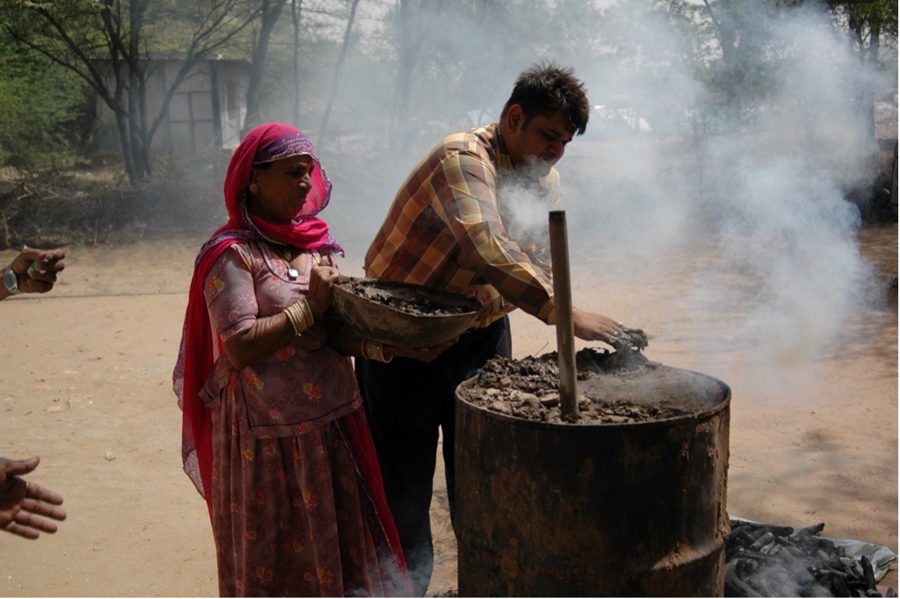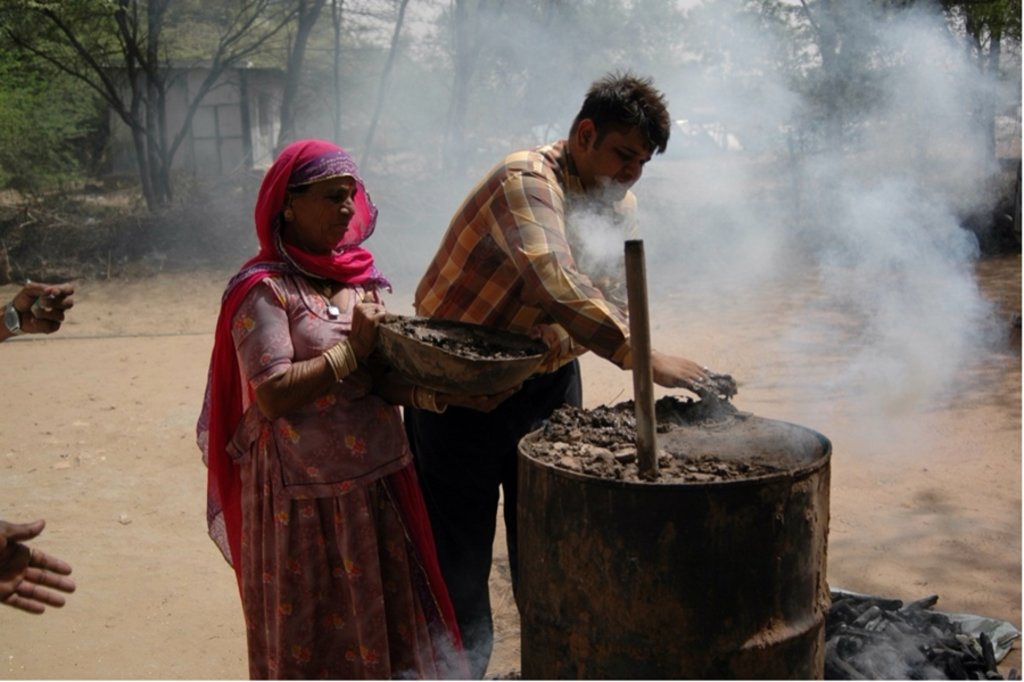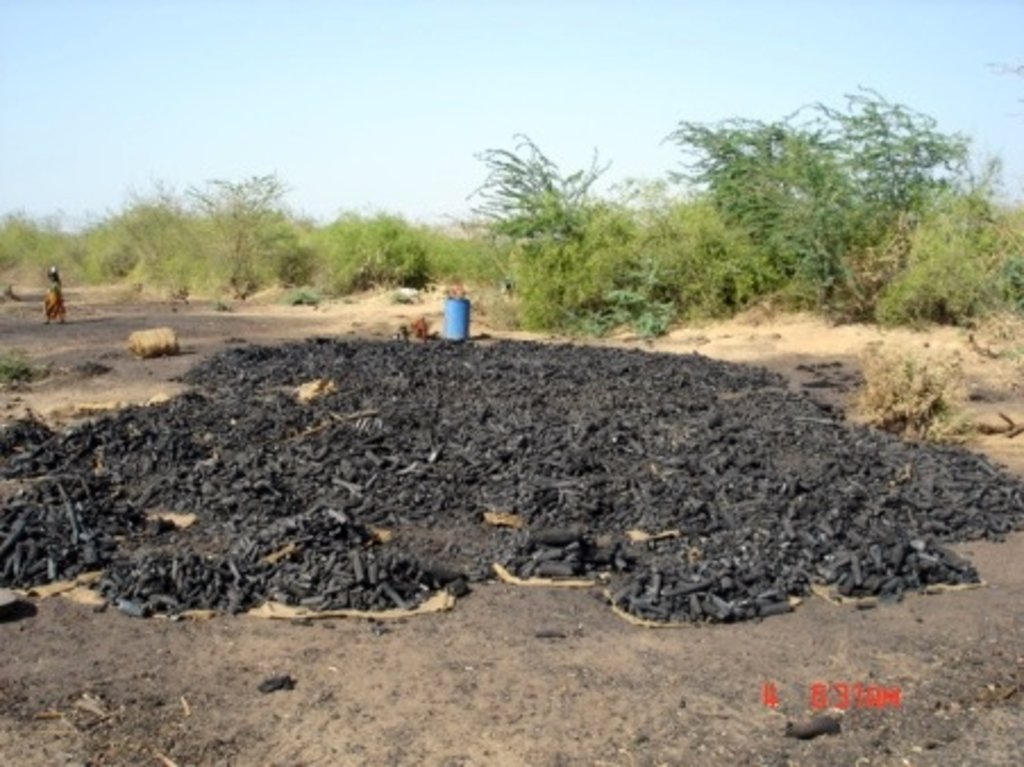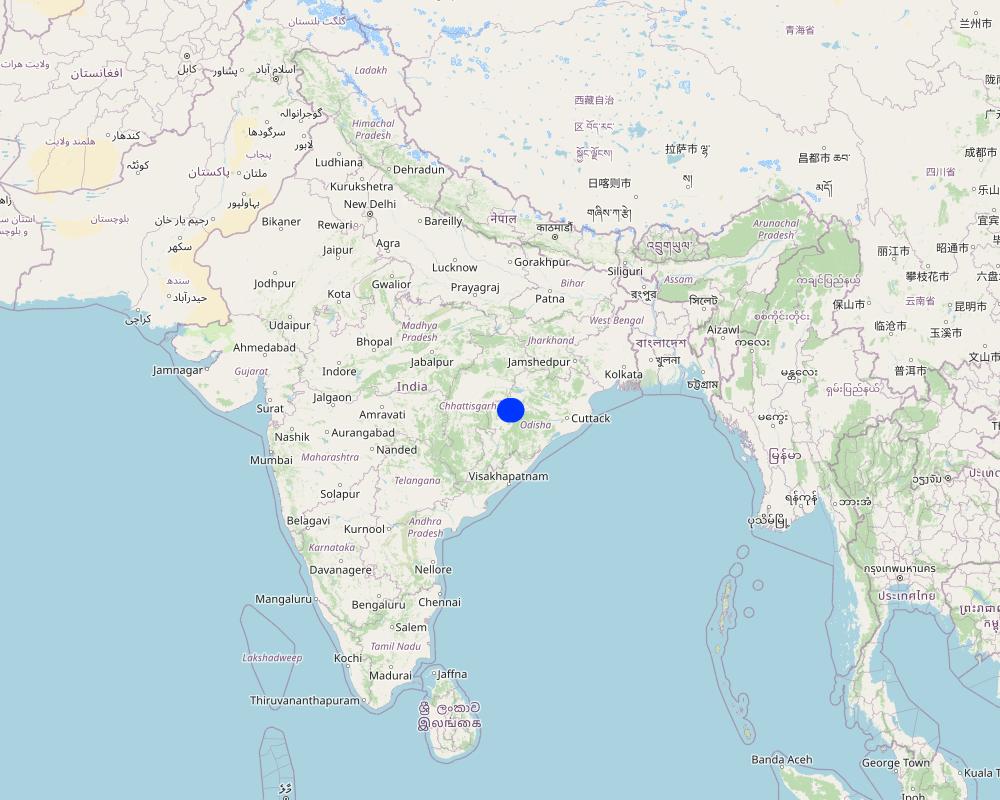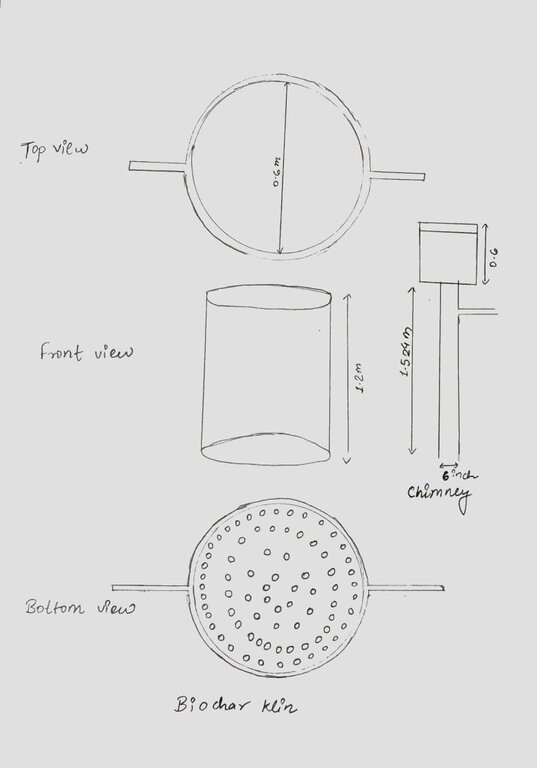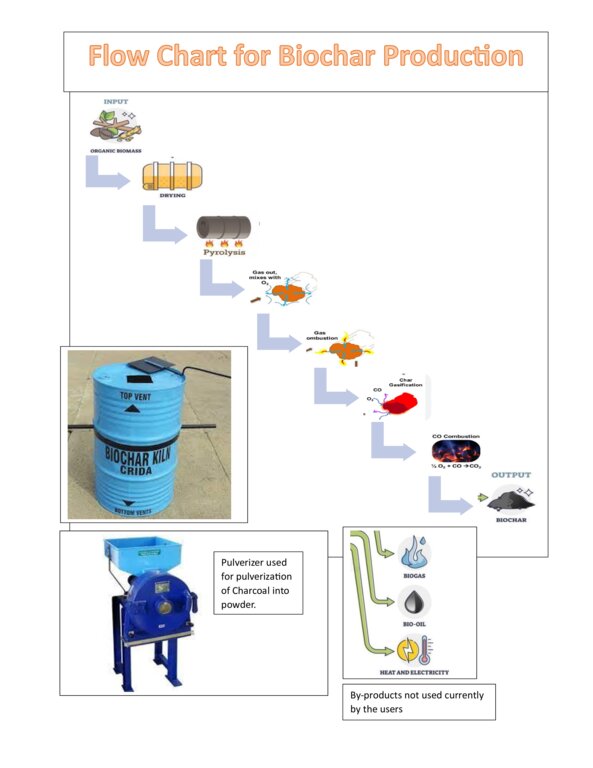Sustainable Biochar Production Through Agroforestry Systems And Its Application [India]
- Creación:
- Actualización:
- Compilador: Santosh Gupta
- Editores: Kim Arora, Stephanie Jaquet
- Revisor: Udo Höggel
technologies_6735 - India
Visualizar secciones
Expandir todo Colapsar todos1. Información general
1.2 Detalles de contacto de las personas de referencia e instituciones involucradas en la evaluación y la documentación de la Tecnología
Nombre del proyecto que financió la documentación/ evaluación de la Tecnología (si fuera relevante)
Soil protection and rehabilitation for food security (ProSo(i)l)Nombre de la(s) institución(es) que facilitaron la documentación/ evaluación de la Tecnología (si fuera relevante)
Deutsche Gesellschaft für Internationale Zusammenarbeit (GIZ) GmbH (GIZ) - AlemaniaNombre de la(s) institución(es) que facilitaron la documentación/ evaluación de la Tecnología (si fuera relevante)
International Centre for Research in Agroforestry (ICRAF) - KeniaNombre de la(s) institución(es) que facilitaron la documentación/ evaluación de la Tecnología (si fuera relevante)
Ecociate Consultants (Ecociate Consultants) - India1.3 Condiciones referidas al uso de datos documentados mediante WOCAT
El compilador y la/s persona(s) de referencia claves aceptan las condiciones acerca del uso de los datos documentados mediante WOCAT:
Sí
1.4 Declaración de la sostenibilidad de la Tecnología descrita
¿La Tecnología aquí descrita resulta problemática en relación a la degradación de la tierra, de tal forma que no puede considerársela una tecnología sostenible para el manejo de la tierra?
No
Comentarios:
The application of biochar to the soil is a technology that can prevent or reduce land degradation by improving soil health through the addition of organic matter, increase soil fertility and the water retention capacity of soils.
1.5 Referencia al (los) Cuestionario(s) de Enfoques MST (documentados usando WOCAT)

Developing professional standards in the installation, maintenance and … [Mali]
Ensure the sustainability of schemes and continuity of production, and reduce production costs
- Compilador: Dieter Nill
2. Descripción de la Tecnología MST
2.1 Breve descripción de la Tecnología
Definición de la Tecnología:
Biochar is a carbon-rich, solid material derived from a wide range of biomass or organic waste through a thermochemical method. It is an organic charcoal material that is the final product of pyrolysis, or high-temperature burning of agricultural biomass without oxygen. Surplus crop residues, agricultural waste, and wood from sustainable sources are used as feedstock (raw material). Such biochar production is linked with agroforestry plantation and agriculture to improve soil health and ensuring sustainable feedstock availability.
2.2 Descripción detallada de la Tecnología
Descripción:
Introduction and Background
Intensive cropping systems coupled with monocropping and high usage of synthetic fertilizers have led to the degradation of soils and depletion of nutrients directly affecting agricultural productivity and farmers' income. Farmers in the Balangir district of Odisha are facing similar challenges. To address these issues and promote sustainable farming practices, a biochar production initiative was introduced by utilizing crop residues and waste material from forests to produce biochar, a carbon-rich material that enhances soil fertility and soil structure. The initiative is a part of the Pro-Soil Project of Deutsche Gesellschaft für Internationale Zusammenarbeit (GIZ), India and implemented by the International Centre for Research in Agroforestry (ICRAF). The technology (a kiln for biochar production) and technical inputs for biochar production were sourced from the Indian Institute of Soil Science, Bhopal.
Biochar is a type of charcoal produced from biomass like agricultural or forest waste or organic materials through a process called pyrolysis. The application of sustainable biochar technology in agroforestry systems can lead to better soil structure, increased water retention, reduced nutrient leaching, and improved crop yields. Moreover, it aids in mitigating greenhouse gas emissions by locking carbon into soil for an extended period.
In the project region farmers used crop residues such as rice straw, wheat straw and residue of other crops along with non-usable biomass from local forests, such as branches, twigs, and leaves, to supplement the feedstock for the pyrolysis. Since the District has large forest areas, the availability of forest waste is no problem. The biochar produced was applied into existing crops fields as well as into agroforestry system. Aiming to promote agroforestry, the project promoted the integration of trees (both fruits and timber) and shrubs into existing agricultural practices. Agroforestry offers multiple benefits such as improved soil health, biodiversity, and carbon sequestration. When sustainable biochar production is integrated into these systems, it can create a sustainable cycle where agricultural waste is converted into biochar, which then enhances soil fertility and sequesters carbon when added back into the soil.
The project has actively involved women farmers, entrepreneurial youth, and farmers' groups in the collection, production and application process of biochar thus promoting community participation and creating awareness about the benefits of biochar.
Implementation
The biochar kiln technology, obtained from the Indian Institute of Soil Science, in Bhopal, is employed to convert biomass into biochar through pyrolysis. This technology ensures efficient and controlled production of high-quality biochar. The collected biomass undergoes a controlled pyrolysis process inside the biochar kiln, where it is burned in the relative absence of oxygen. Technical specialization during production includes kiln temperature control, feedstock preparation, and the management of pyrolysis gases to ensure efficient biochar production. This results in the conversion of biomass into biochar, also leaving behind bioenergy-rich gases. Quality control measures are implemented to ensure the production of biochar with optimal characteristics, including high carbon content, porosity, and stability.
The Biochar kiln used was designed with the aim to optimize temperature control and ensure efficient conversion of biomass. An efficient loading mechanism allows easy and controlled feeding of biomass into the kiln. This ensures a consistent flow of material during the pyrolysis process. Although local kilns are usually not equipped with temperature control mechanisms to regulate the pyrolysis temperature, the temperature in the kilns may alternatively be regulated through the rate of feeding biomass into the kilns. Such kilns usually have some safety features and proper ventilation so to prevent accidents.
To implement this technology the ICRAF conducted training sessions for farmers on the proper preparation and application of biochar. The trainings were focused on the following aspects:
-The collection and drying process for agriculture and forest waste
-The management of operations for the biochar kiln including the loading of raw material (feedstock) into the kiln, its burning, operation-timing, period check, volumes of raw material to be fed etc.
-Precautions to be taken during the process
-The quality check of prepared biochar charcoal and the process for pulverizing it
-Dosage recommendations for different crops as per local conditions
-The mixing of biochar with cow dung and cow urine before application
-Integration with existing farming practices and the long-term benefits of biochar on soil health
Impact and Knowledge Transfer
The biochar acts as a soil conditioner, enhancing water retention, nutrient availability, and microbial activity. The benefits and impacts on improved fertility, increased water retention, and reduced nutrient leaching, lead to higher crop yields and resilience against climate variability, carbon sequestration aids in reducing greenhouse gas emissions, contributing to global efforts to combat climate change, and utilizing agricultural residues reduces air pollution from open burning and provides a sustainable solution for organic waste disposal. Land users appreciated the enhanced soil productivity and environmental benefits brought by biochar. Overall, the Sustainable Biochar Production Technology represents a promising approach in sustainable agriculture and environmental stewardship.
The project team, in collaboration with local agricultural extension services and the Indian Institute of Soil Science, monitored the impact of biochar application on soil health parameters. This involved regular soil testing, crop yield assessments and feedback from participating farmers. In fact, they also measured the impact of biochar made from different feedstock (raw materials). Success stories were shared with neighboring communities, public stakeholders and researchers and encouraged the further adoption of sustainable soil management practices.
The biochar production initiative in the Balangir District of Odisha in India demonstrates a sustainable approach to addressing soil health issues using locally available resources. Through the collaboration between ICRAF and GIZ, this project not only improves soil fertility but also empowers local communities by providing them with sustainable solutions for agricultural challenges. The success of this intervention serves as a model for future initiatives aimed at promoting environmentally friendly and community-driven approaches to agriculture.
2.3 Fotografías de la Tecnología
2.4 Videos de la Tecnología
Comentarios, descripción breve:
https://www.youtube.com/watch?v=qHpIPVX2mR8&t=8s
Lugar:
Bhopal, MP
Nombre del videógrafo:
ICAR-CIAE
2.5 País/ región/ lugares donde la Tecnología fue aplicada y que se hallan comprendidos por esta evaluación
País:
India
Región/ Estado/ Provincia:
Odisha
Especifique la difusión de la Tecnología:
- aplicada en puntos específicos/ concentrada en un área pequeña
¿El/los sitio(s) de la Tecnología se ubica(n) en un área de protección permanente?
No
Map
×2.6 Fecha de la implementación
Indique año de implementación:
2021
2.7 Introducción de la Tecnología
Especifique cómo se introdujo la Tecnología:
- durante experimentos/ investigación
- mediante proyectos/ intervenciones externas
Comentarios (tipo de proyecto, etc.):
Piloting best practices to produce biochar using diverse feedstock and its application
3. Clasificación de la Tecnología MST
3.1 Propósito(s) principal(es) de la Tecnología MST
- mejorar la producción
- reducir, prevenir, restaurar la degradación de la tierra
- conservar el ecosistema
- preservar/ mejorar biodiversidad
- adaptarse al cambio climático/ extremos climáticos y sus impactos
- crear impacto económico benéfico
3.2 Tipo(s) actuales de uso de la tierra donde se aplica la Tecnología
Mezcla de tipos de uso de tierras dentro de la misma unidad de tierras: :
No

Tierras cultivadas
- Cosecha anual
- Cosecha de árboles y arbustos
Cosechas anuales - Especifique cultivos:
- cereales - mijo
- cereales - arroz (tierras altas)
Cultivos de matorrales y arbustos - Especifique cultivos:
- árboles para forraje (Calliandra, Leucaena leucocephala, Prosopis, etc.)
- frutas, otros
Número de temporadas de cultivo por año:
- 2
Especifique:
Mostly farmers are cultivating during the monsoon season as these are the rainfed farmers. Some farmers with irrigation facilities are cultivating in winter season as well
¿Se practica el intercultivo?
Sí
Si respondió que sí, especifique qué cultivos son intercultivados:
Millets and other cereals
¿Se practica la rotación de cultivos?
Sí
Si fuera el caso, especifique :
Cereals, Pulses, Fodder crops

Bosques
- Bosques/ zonas boscosas (semi) naturales
Bosques/ zonas boscosas (semi-) naturales: Especifique tipo de manejo:
- Eliminación de madera muerta/ de poda
¿Los árboles especificados son deciduos o imperecederos?
- mixto deciduo/ imperecedero
Productos y servicios:
- Madera
- Leña
- Frutos y nueces
- Pastoreo/ ramoneo

asentamientos, infraestructura
- Asentamientos, edificios
3.3 ¿Cambió el uso de tierras debido a la implementación de la Tecnología?
¿Cambió el uso de tierras debido a la implementación de la Tecnología?
- No (Continúe con la pregunta 3.4)
3.4 Provisión de agua
Provisión de agua para la tierra donde se aplica la Tecnología:
- mixta de secano – irrigada
Comentarios:
Most farmers are cultivating in rainfed conditions while some also have irrigation facilities
3.5 Grupo MST al que pertenece la Tecnología
- cobertura de suelo/ vegetal mejorada
- cosecha de agua
- manejo de desperdicios/ manejo de aguas residuales
3.6 Medidas MST que componen la Tecnología

medidas agronómicas
- A1: vegetación/ cubierta del suelo
- A2: materia orgánica/ fertilidad del suelo
- A3: Tratamiento de superficie del suelo
- A6: Manejo de residuos

medidas vegetativas
- V4:reemplazo o eliminación de especies extrañas/ invasoras
- V5: Otros

medidas de manejo
- M6: Manejo de desperdicios (reciclado, reutilización o reducción)

otras medidas
Especifique:
Climate resilient soil management by application of biochar using varied feedstock (rwa material) generated through agroforestry
3.7 Principales tipos de degradación de la tierra encarados con la Tecnología

erosión de suelos por agua
- Wt: pérdida de capa arable/ erosión de la superficie

deterioro físico del suelo
- Ps: hundimiento de suelos orgánicos, asentamiento del suelo

degradación biológica
- Bl: pérdida de la vida del suelo
3.8 Prevención, reducción o restauración de la degradación de la tierra
Especifique la meta de la Tecnología con relación a la degradación de la tierra:
- reducir la degradación de la tierra
- restaurar/ rehabilitar tierra severamente degradada
4. Especificaciones técnicas, actividades de implementación, insumos y costos
4.1 Dibujo técnico de la Tecnología
Especificaciones técnicas (relacionadas al dibujo técnico):
The single barrel biochar klin was developed by the Indian Institute of Soil Sciences in Bhopal (IISS). The Kiln had already been designed and commercialised by the IISS. Land users can buy a metallic kiln unit from the IISS or get it fabricated from local fabricators based on the design specifications suggested in the drawing.
Autor:
Payal Dewangan
Fecha:
12/07/2023
Especificaciones técnicas (relacionadas al dibujo técnico):
The flowchart provides a step by step guide for biochar production in the project area by land users
Autor:
Payal and Santosh
Fecha:
20/11/2023
4.2 Información general sobre el cálculo de insumos y costos
Especifique cómo se calcularon los costos e insumos:
- por unidad de Tecnología
Especifique unidad:
200 L capacity
Especifique las dimensiones de la unidad (si fuera relevante):
Litre
otra / moneda nacional (especifique):
INR
Si fuera relevante, indique la tasa de cambio de dólares americanos a la moneda local (ej. 1 U$ = 79.9 Reales Brasileros): 1 U$ =:
80,0
Indique el costo promedio del salario de trabajo contratado por día:
204 Rupees
4.3 Actividades de establecimiento
| Actividad | Momento (estación) | |
|---|---|---|
| 1. | Purchase of biochar kiln unit | Can be done any time during the year but need to be ready before the month of September |
| 2. | Purchase of pulveriser | Need to be purchased once and before the start of biochar production |
Comentarios:
Both biochar kiln and pulveriser are fixed investments and can last up to 5 years
4.4 Costos e insumos necesarios para el establecimiento
| Especifique insumo | Unidad | Cantidad | Costos por unidad | Costos totales por insumo | % de los costos cubiertos por los usuarios de las tierras | |
|---|---|---|---|---|---|---|
| Equipo | Biochar Klin | Rs. | 1,0 | 7000,0 | 7000,0 | |
| Equipo | Pulvariser unit | Rs. | 1,0 | 20000,0 | 20000,0 | |
| Costos totales para establecer la Tecnología | 27000,0 | |||||
| Costos totales para establecer la Tecnología en USD | 337,5 | |||||
Si el usuario de la tierra no cubrió el 100% de los costos, indique quién financió el resto del costo:
The project paid towards the fixed investment costs of biochar kiln and pulverizier unit
4.5 Actividades de establecimiento/ recurrentes
| Actividad | Momento/ frequencia | |
|---|---|---|
| 1. | Collecting the crop residues and forest waste | Needs to be collected and dried before the start of biochar production unit (September and June) |
| 2. | Preparation of Biochar | Before the sowing of Rabi (winter) and Kharif (summer) seasons (Months of September/October and June/July) |
| 3. | Application of biochar in the field | During the cropping season |
Comentarios:
These activities may vary based on the cropping pattern and farmers' need of biochar application
4.6 Costos e insumos necesarios para actividades de mantenimiento/ recurrentes (por año)
| Especifique insumo | Unidad | Cantidad | Costos por unidad | Costos totales por insumo | % de los costos cubiertos por los usuarios de las tierras | |
|---|---|---|---|---|---|---|
| Mano de obra | Preparation of biochar | Person-day | 2,0 | 200,0 | 400,0 | 100,0 |
| Mano de obra | Application of biochar in the field | Person-day | 1,0 | 200,0 | 200,0 | 100,0 |
| Fertilizantes y biocidas | Farmyard manure | Rs. | 20,0 | 5,0 | 100,0 | 100,0 |
| Fertilizantes y biocidas | Fertilizer | Rs. | 50,0 | 7,0 | 350,0 | 100,0 |
| Indique los costos totales para mantenecer la Tecnología | 1050,0 | |||||
| Costos totales para mantener la Tecnología en USD | 13,13 | |||||
Comentarios:
The application of biochar was practiced by land users twice in a year, before sowing kharif and rabi crops. The amount of maintenance activities of the technology is count double for a year as farmers are practicing the biochar technology for two seasons in a year.
4.7 Factores más determinantes que afectan los costos:
Describa los factores más determinantes que afectan los costos:
The investment towards the purchase of the kiln- and the pulveriser unit. In the documented project, the investment costs were borne by the project. Therefore, smallholder farmers may find it difficult to purchase the hardware units of kiln and pulveriser, given such investment costs.
5. Entorno natural y humano
5.1 Clima
Lluvia anual
- < 250 mm
- 251-500 mm
- 501-750 mm
- 751-1,000 mm
- 1,001-1,500 mm
- 1,501-2,000 mm
- 2,001-3,000 mm
- 3,001-4,000 mm
- > 4,000 mm
Especifique el promedio anual de lluvia (si lo conoce), en mm:
1288,00
Indique el nombre de la estación metereológica de referencia considerada:
Bhubaneshwar, Odisha
Zona agroclimática
- Sub-húmeda
The District is located under the West Central Table Land Agro Climatic Zone characterized by hot and sub-humid climate
5.2 Topografía
Pendientes en promedio:
- plana (0-2 %)
- ligera (3-5%)
- moderada (6-10%)
- ondulada (11-15%)
- accidentada (16-30%)
- empinada (31-60%)
- muy empinada (>60%)
Formaciones telúricas:
- meseta/ planicies
- cordilleras
- laderas montañosas
- laderas de cerro
- pies de monte
- fondo del valle
Zona altitudinal:
- 0-100 m s.n.m.
- 101-500 m s.n.m.
- 501-1,000 m s.n.m
- 1,001-1,500 m s.n.m
- 1,501-2,000 m s.n.m
- 2,001-2,500 m s.n.m
- 2,501-3,000 m s.n.m
- 3,001-4,000 m s.n.m
- > 4,000 m s.n.m
Indique si la Tecnología se aplica específicamente en:
- no relevante
Comentarios y especificaciones adicionales sobre topografía :
Balangir District is divided into four Agro-Ecological situations (AES) and characterized by a hot dry summer and highly erratic rainfall distribution of south-west monsoon rains, i.e., (i) plain land irrigated, (ii) plain land rainfed (iii) undulating plain drought-prone and (iv) undulating sub-mountainous tract rainfed.
The altitude of the Bolangir district is 207 masl.
5.3 Suelos
Profundidad promedio del suelo:
- muy superficial (0-20 cm)
- superficial (21-50 cm)
- moderadamente profunda (51-80 cm)
- profunda (81-120 cm)
- muy profunda (>120 cm)
Textura del suelo (capa arable):
- áspera/ ligera (arenosa)
- fina/ pesada (arcilla)
Textura del suelo (> 20 cm debajo de la superficie):
- áspera/ ligera (arenosa)
- fina/ pesada (arcilla)
Materia orgánica de capa arable:
- baja (<1%)
Si se halla disponible, adjunte una descripción completa de los suelos o especifique la información disponible, por ej., tipo de suelo, pH/ acidez de suelo, capacidad de intercambio catiónico, nitrógeno, salinidad, etc. :
Mixed red and yellow soils occur as catenary associations in undulating and rolling terrains which differ in depth, texture, and color. Red and yellow soils are moderately shallow in depth and coarse-textured. Upland soils are shallower and lighter in texture than low-land soils.
Red and black soils are light to medium textured having neutral pH. These soils occur in mixed forms of both red & black soil together in which black soils occur in patches within the predominant red soils.
Black soils are mostly found in Puintala Block and in some parts of Loisingha Block. The soils are heavier in texture having clay content more than 30%. Clay minerals are predominant with smectites due to which deep cracks are seen to develop during summer.
Laterite soils are generally distributed in a few limited patches in the Balangir District. These soils are loamy sand to sandy loam in the surface having a hard clay pan in the subsoil. Crusting is a problem in upland literite.
Brown forest soils are mostly found in Khaprakhol, Tureikela, Bangomunda, Titilagarh, Saintala, and Gudvella Block. These soils are brown to grey-brown in color, light textured, and acidic in reaction.
5.4 Disponibilidad y calidad de agua
Agua subterránea:
5-50 m
Disponibilidad de aguas superficiales:
bueno
Calidad de agua (sin tratar):
agua potable de mala calidad (requiere tratamiento)
La calidad de agua se refiere a:
agua subterránea y superficial
¿La salinidad del agua es un problema?
Sí
Especifique:
Balangir District falls within the Western Plateau and Hills Zone of Odisha, characterized by a semi-arid climate. The agro-climatic conditions include hot summers, limited rainfall, and erratic monsoons, which pose challenges for agriculture due to water scarcity. In many regions of Odisha, including Balangir, water salinity is a significant concern, especially in areas relying on groundwater sources.
¿Se está llevando a cabo la inundación del área? :
No
Comentarios y especificaciones adicionales sobre calidad y cantidad de agua:
The groundwater level at 3 meters below ground level in 2019 indicates water table that lies within 3-5 meters below ground level (m bgl) or less is considered shallow. This level often indicates good accessibility to groundwater, making it relatively easier for extraction using shallow wells or hand pumps.
5.5 Biodiversidad
Diversidad de especies:
- elevada
Diversidad de hábitats:
- elevada
Comentarios y especificaciones adicionales sobre biodiversidad:
The Odisha Government has declared the Gandhamardan Hill Range in Bargarh and Balangir Districts a Biodiversity Heritage Site (BHS).
5.6 Las características de los usuarios de la tierra que aplican la Tecnología
Orientación del mercado del sistema de producción:
- subsistencia (autoprovisionamiento)
Ingresos no agrarios:
- menos del 10% de todos los ingresos
Nivel relativo de riqueza:
- pobre
Individuos o grupos:
- individual/ doméstico
- grupos/ comunal
Nivel de mecanización:
- trabajo manual
- tracción animal
Género:
- mujeres
- hombres
Edad de los usuarios de la tierra:
- jóvenes
- personas de mediana edad
Indique otras características relevantes de los usuarios de las tierras:
There are a number of women self help groups and farmer producer organisations being formed in the district as part of Government programs
5.7 Área promedio de la tierra usada por usuarios de tierra que aplican la Tecnología
- < 0.5 ha
- 0.5-1 ha
- 1-2 ha
- 2-5 ha
- 5-15 ha
- 15-50 ha
- 50-100 ha
- 100-500 ha
- 500-1,000 ha
- 1,000-10,000 ha
- > 10,000 ha
¿Esto se considera de pequeña, mediana o gran escala (refiriéndose al contexto local)?
- pequeña escala
5.8 Tenencia de tierra, uso de tierra y derechos de uso de agua
Tenencia de tierra:
- individual, con título
Derechos de uso de tierra:
- individual
Derechos de uso de agua:
- comunitarios (organizado)
- individual
¿Los derechos del uso de la tierra se basan en un sistema legal tradicional?
No
Comentarios:
The majority of the farmers in the district are smallholder farmers with agriculture being mostly rained, except some areas with irrigation facilities from the nearby dam
5.9 Acceso a servicios e infraestructura
salud:
- pobre
- moderado
- bueno
educación:
- pobre
- moderado
- bueno
asistencia técnica:
- pobre
- moderado
- bueno
empleo (ej. fuera de la granja):
- pobre
- moderado
- bueno
mercados:
- pobre
- moderado
- bueno
energía:
- pobre
- moderado
- bueno
caminos y transporte:
- pobre
- moderado
- bueno
agua potable y saneamiento:
- pobre
- moderado
- bueno
servicios financieros:
- pobre
- moderado
- bueno
Comentarios:
The district is located in the interior parts of eastern India and considered as a backward district with poor access to infrastructure and other facilities
6. Impactos y comentarios para concluir
6.1 Impactos in situ demostrados por la Tecnología
Impactos socioeconómicos
Producción
producción de cultivo
Comentarios/ especifique:
For Wood Biochar or Wood Coconut Husk Biochar (WCB), or Crop Residue Biochar (CRB) the highest grain yield of the crop was recorded with the highest dose of biochar, fertilizer, and manure application. Also, it's application significantly improved the straw yield
calidad de cultivo
Comentarios/ especifique:
The application of Wood Biochar or Wood Coconut Husk Biochar (WCB), or Crop Residue Biochar (CRB) with manure also significantly improved the quality of the crop
producción de forraje
Comentarios/ especifique:
It was found with significantly improved straw yield the availability of fodder for the livestock also increased
calidad de forraje
Comentarios/ especifique:
It was recorded that the quality of the crop also the quality of the straw also improved.
riesgo de fracaso de producción
Comentarios/ especifique:
It was observed that the crop in which the application of biochar was with the manure and fertilizer, the crop had better adaptation and standing properties in comparison to another crop without the application of biochar.
manejo de tierras
Ingreso y costos
ingreso agrario
Comentarios/ especifique:
The yield for the crop in which application was done was increased which led to an increase in income
Impactos socioculturales
seguridad alimentaria/ autosuficiencia
Impactos ecológicos
Ciclo de agua/ escurrimiento de sedimento
cosecha/ recolección de agua
Comentarios/ especifique:
Water retention from the soil increased because of the increase in soil organic matter and carbon content
escurrimiento superficial
Comentarios/ especifique:
The water holding capacity of the water increased leading to less surface runoff from the field.
evaporación
Suelo
humedad del suelo
Comentarios/ especifique:
With an increase in soil organic matter and improved soil texture the soil moisture increased
pérdida de suelo
Comentarios/ especifique:
The semi-arid climate and limited rainfall, combined with sporadic and intense monsoons, can lead to soil erosion. When rainfall does occur, it can cause rapid runoff, carrying away the topsoil due to the lack of vegetation cover or inadequate soil conservation measures.
ciclo/ recarga de nutrientes
Comentarios/ especifique:
The application of biochar with manure and fertilizers not only increased the nutrients in the soil but also increased the nutrient uptake of plants from the soil.
salinidad
Comentarios/ especifique:
Biochar can act as a soil amendment to moderate soil pH depending on the initial pH level. Scientifically, biochar tends to be pH neutral, so its impact on soil pH depends on the existing soil condition. The impact of biochar on pH is often gradual and depends on various factors like the type and composition of biochar, soil characteristics and environmental conditions. Biochar acts more as a buffer, stabilizing soil pH over time rather than making drastic immediate changes.
materia orgánica debajo del suelo C
Biodiversidad: vegetación, animales
Cubierta vegetal
Comentarios/ especifique:
The plant biomass as well as the vegetative growth of the plant showed a significant positive reaction to the biochar application on crops
biomasa/ sobre suelo C
diversidad vegetal
control de pestes/ enfermedades
Comentarios/ especifique:
Resistance of the crop increases with better uptake of K from the soil. Plants become more resistant to disease and pests.
Reducción de riesgos de desastres y riesgos climáticos
emisión de carbono y gases de invernadero
Especifique la evaluación de los impactos en el sitio (mediciones):
In the context of regions like Balangir, where salinity and soil loss are concerns, biochar's ability to improve soil structure and fertility without altering pH drastically could be beneficial. It helps mitigate soil erosion by enhancing soil health and resilience, thus contributing to sustainable agriculture practices in these challenging environments.
6.3 Exposición y sensibilidad de la Tecnología al cambio climático gradual y a extremos relacionados al clima/ desastres (desde la percepción de los usuarios de tierras)
Cambio climático gradual
Cambio climático gradual
| Estación | Incremento o reducción | ¿Cómo es que la tecnología soporta esto? | |
|---|---|---|---|
| temperatura anual | incrementó | moderadamente | |
| temperatura estacional | verano | incrementó | moderadamente |
| lluvia anual | disminuyó | bien | |
| lluvia estacional | estación húmeda/ de lluvias | disminuyó | moderadamente |
Extremos (desastres) relacionados al clima
Desastres climatológicos
| ¿Cómo es que la tecnología soporta esto? | |
|---|---|
| sequía | moderadamente |
Comentarios:
Overall biochar improves the soil health and helps soil to maintain the moisture thus it is better suited to some of the climatic conditions such as low rainfall, delayed rains etc. However in case of extreme climatic conditions, technology alone may not mitigate the impact.
6.4 Análisis costo-beneficio
¿Cómo se comparan los beneficios con los costos de establecimiento (desde la perspectiva de los usuarios de tierra)?
Ingresos a corto plazo:
positivo
Ingresos a largo plazo:
muy positivo
¿Cómo se comparan los beneficios con los costos de mantenimiento/ recurrentes (desde la perspectiva de los usuarios de tierra)?
Ingresos a corto plazo:
muy positivo
Ingresos a largo plazo:
muy positivo
Comentarios:
The benefits of technology to soil health, crop productivity and crop quality is much higher than the cost of establishment and maintenance
6.5 Adopción de la Tecnología
- casos individuales / experimentales
Si tiene la información disponible, cuantifique (número de hogares y/o área cubierta):
100
De todos quienes adoptaron la Tecnología, ¿cuántos lo hicieron espontáneamente, por ej. sin recibir nada de incentivos/ materiales:
- 0-10%
Comentarios:
It was mostly done as part of the PRO-SOIL PROJECT
6.6 Adaptación
¿La tecnología fue modificada recientemente para adaptarse a las condiciones cambiantes?
Sí
Si fuera así, indique a qué condiciones cambiantes se adaptó:
- disponibilidad de mano de obra (ej. debido a migración)
Especifique la adaptación de la Tecnología (diseño, material/ especies, etc.):
Refinements in pyrolysis methods and technologies to produce biochar with specific characteristics suited to diverse soil types and climate conditions. This includes adjusting temperature, duration, and feedstock to optimize biochar properties like porosity and water retention capacity. Innovations in application techniques to improve the efficiency and effectiveness of biochar incorporation into agricultural systems. This involves exploring precision application methods, such as localized placement or mixing with organic amendments, to ensure better distribution and utilization of biochar in the root zone. Emphasis on integrating biochar technology into climate-smart agricultural practices, focusing on sustainable intensification while adapting to changing climatic conditions. This involves promoting practices that enhance resilience to drought, water conservation and soil fertility improvement.
6.7 Fuerzas/ ventajas/ oportunidades de la Tecnología
| Fuerzas/ ventajas/ oportunidades desde la perspectiva del usuario de la tierra |
|---|
| The soil moisture, soil texture, water retention and water-holding capacity of the soil increases. The uptake of nutrients increases which leads to less application of fertilizers in the field |
| There was an increase in crop yield, straw yield, vegetative mass growth, more grains or fruits per plant, and fewer pests & disease attacks on the plants were noticed |
| The better use of crop residue from the field increase the soil fertility and promoted better crop growth |
| Fuerzas/ ventajas/ oportunidades desde la perspectiva del compilador o de otra persona de referencia clave |
|---|
| The use of biochar helps to combat the climate crisis by sequestering atmospheric carbon into soil as well as processing agricultural and other waste into useful clean energy |
| The application of biochar significantly changes the soil’s properties (texture, porosity, bulk density, particle density, surface area, pore size distribution, cation exchange capacity, pH, and water-holding capacity) which, directly influence plant growth |
| High porosity and a large surface area of biochar provide space for micro-organisms that are beneficial for the soil and help in binding important anions and cations, improving soil health and enhancing crop productivity |
| Reduced nitrous oxide and methane emissions when biochar is applied to the soil |
6.8 Debilidades/ desventajas/ riesgos de la Tecnología y formas de sobreponerse a ellos
| Debilidades/ desventajas/ riesgos desde la perspectiva del usuario de la tierra | ¿Cómo sobreponerse a ellas? |
|---|---|
| Need large quantities of wood and crop residue for biochar production on a larger scale |
A better planning for crop residue management and access to communities to collect forest waste from forest can easily address this problem Exploring alternative biomass sources like agricultural residues, crop waste, or dedicated energy crops can reduce reliance on wood or coconut shells, promoting sustainable sourcing. Also, advancements in pyrolysis technologies to optimize biochar production from smaller quantities of biomass, improving efficiency and reducing the overall demand. |
| Do not have knowledge about how this biochar can be sold in the market for additional income |
Creating more awareness among the farmers about biochar will create a market demand for it. Conducting market assessments and creating awareness among potential buyers about the benefits of biochar for soil improvement, carbon sequestration, and agricultural productivity. Exploring the development of value-added products or applications derived from biochar, such as soil amendments, filtration systems, or compost blends, to diversify market opportunities. |
| Debilidades/ desventajas/ riesgos desde la perspectiva del compilador o de otra persona de referencia clave | ¿Cómo sobreponerse a ellas? |
|---|---|
| The availability of suitable wood and coconut for biochar production can be limited, and there may be competition between biochar production and other uses of biomass, such as food and fuel production | The innovation in technology where biochar can be produced with lesser amount of feedstock will be a great solution |
| If not managed sustainably, the production of biomass feedstock for biochar can lead to deforestation or the conversion of natural ecosystems into monoculture plantations, which can have negative ecological consequences |
The promotion of agro-forestry is important to ensure the availability of feed stock while also ensuring the increased coverage of forest. The training of land users and other stakeholders around sustainable biochar production. |
7. Referencias y vínculos
7.1 Métodos/ fuentes de información
- entrevistas con usuarios de tierras
4
- entrevistas con especialistas/ expertos en MST
3
- compilación de informes y otra documentación existente
5
¿Cuándo se compilaron los datos (en el campo)?
07/07/2023
7.2 Vínculos a las publicaciones disponibles
Título, autor, año, ISBN:
IBI publication at International Biochar Initiative
¿Dónde se halla disponible? ¿Costo?
https://biochar-international.org/resources/ibi-publications/
7.3 Vínculos a la información relevante disponible en línea
Título/ descripción:
About Balangir District
URL:
https://balangir.nic.in/about-district/
Título/ descripción:
Water Resources of Balangir District (Minor Irrigation Division, Balangir)
URL:
https://balangir.nic.in/water-resources/
Título/ descripción:
Senior Geologist, Ground Water Survey & Investigation Division, Balangir
URL:
https://www.rtiodisha.gov.in/Pages/printAllManual/office_id:2710/lang:
7.4 Comentarios generales
This documentation not only follows the land user interview findings but also follows the results mentioned in the internal report after the experimentation
Vínculos y módulos
Expandir todo Colapsar todosVínculos

Developing professional standards in the installation, maintenance and … [Mali]
Ensure the sustainability of schemes and continuity of production, and reduce production costs
- Compilador: Dieter Nill
Módulos
No se hallaron módulos


